 BRATISLAVA BRATISLAVA |
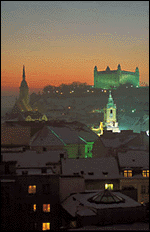
Bratislava is one of the most beautiful towns on the Danube River. The town influenced by the language and the cultures of three nations - Slovak, Austrian and Hungarian - have mixed over centuries. The town itself, in particular its historical core, is a real manual of the history of European culture and civilization.
Bratislava is the most populous city in the Slovak Republic with a population of 450 000. Not only is Bratislava the largest city in Slovakia, it also serves as the state capital. Furthermore, Bratislava is the seat of the National Council of the Slovak Republic, the Government of the Slovak Republic, national ministries and the other central bodies of the state administration of the Slovak Republic. It is situated in the center of Europe in the southwestern part of Slovakia. It borders with Hungary in the south and with Austria in the west. Founded before the 10th century, the city was known originally as Pressburg.
Strong fortifications erected during the 12th century gave it strategic importance; from 1541 to 1784 it was the capital of Hungary. In 1805, during the Napoleon War, French Emperor Napoleon I met the Holy Roman Emperor Francis II in the Primate's Palace and imposed the peace terms known as the Treaty of Pressburg. When Czechoslovakia was created in 1919 after World War I, the city was renamed Bratislava and made capital of the province of Slovakia. The Danube River serves as a natural resource for travel, trade and, in the summer, pleasant walks along its banks.
The capital of Slovakia, Bratislava lies at the crossroads of important trade routes connecting Vienna and Budapest. Thanks to this favorable location, the town has always been closely connected with European art and culture. Situated on both banks of the Danube, the biggest river in Europe, Bratislava lies directly below the Little Carpathian Mountains in Southwest Slovakia. At a place where the borders of three countries converge - Slovakia, Hungary and Austria - the Danube has attracted people for many years. First it lured those who came with merchandise. Along the river, cultures of the Orient penetrated to the North.
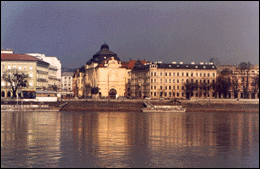
The famous Bernstein Road to the North Sea, used by merchants for transportation of their precious goods, crossed this area. Defense lines of Limes Romanum situated along their camps, fortresses and watchtowers ran across this area as well.
Today, new bridges span across the Danube, connecting the new residential area with the Old Town. The most familiar landmark - Bratislava Castle - dominates the city. Other familiar sights are St. Martin's Cathedral and historic buildings representing all architectural styles from Gothic, to Art Nouveau. Bratislava, the former coronation site of Austrian emperors, warmly welcomes visitors and admirers of historic and cultural monuments, as well as lovers of good food and delicious wine.
Accommodation
Located just a few steps from the Bratislava Castle and Bratislava's biggest church, the St. Martin's Cathedral, Hotel Danube offers you an excellent opportunity of a top-class accommodation. Situated directly in the heart of the Old Town, you can enjoy a view on Danube River from your hotel room. Danube Hotel is the only one four diamond hotel in Bratislava owned and operated by a French company, that guarantees clearly-defined, high quality standards and service levels as well as the individual charm, and local hospitality. It has 276 guest rooms on 4 floors, including 268 double rooms, 8 suites, business centre and executive floor. "Our development here went along with the development of the economic and political framework of the country," says Director of the Danube Hotel, Mr. Serge Yu. The trans-atlantic travelers can find the seat of American Chamber of Commerce in the hotel.
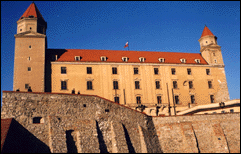
Often referred to as "the upside down table", the Castle ranks among the most significant Bratislava's dominant buildings. It was first mentioned in a written document in 907. A Castle palace with a central house was built on the foundations of older buildings during the rule of Hungarian King Sigismund of Luxembourg in the 15th century. Then the Castle of Bratislava gained its typical present day silhouette with four-corner tower. It played an important role during the reign of the Habsburg Empress Maria Theresia who had it rebuilt into a representative royal residence.
In 1811 the Castle burnt down together with the annexes and considerable part of the settlement below the castle. Following the reconstruction in 1953-1968 the royal residence was adapted to the needs of state representation. The castle houses also historical exhibitions of the Slovak National Museum.
 St. Martin's Cathedral (Dom svateho Martina) St. Martin's Cathedral (Dom svateho Martina) |
The main church of the city dates back to the 13th century. The spire was actually part of the city defense line. On the 85-meter-high steeple there is a golden pillow (2x2 m), which carries a copy of the Hungarian royal crown as a sign that St. Martin's Cathedral was the coronation church of Hungarian kings in the 16th century. From 1563 to 1830, 11 Hungarian kings and 8 royal wives were crowned here.
 Old Town Hall (Stara radnica) Old Town Hall (Stara radnica) |
This precious 15th century building houses the Municipal Museum. The Town Hall courtyard with romantic arcades offers a beautiful background for theatre performances and summer trumpet concerts. In the corner of the courtyard is the entrance to the Municipal Museum, established in 1868. The Municipal Museum is one of the oldest museums in Bratislava. In the rooms of the Old Town Hall an exhibition showing the history of the town from ancient times up to the present is situated. Part of the Old Town Hall is the archives, which preserve materials documenting the political, social, economic and cultural history of the town, society of Bratislava, and individuals from the middle of the 12th century.
 Primatial Palace (Primacialny palac) Primatial Palace (Primacialny palac) |
Originally it was the residence of the Archbishop
of Estergom. Among the most famous historic events
that took place in the Mirror Hall was the signing
of Bratislava Peace Treaty with Napoleon in 1805,
between Napoleonic France and Habsburg Austria after
the battle at Slavkov. Representative rooms are
used to display permanent exhibition of old European
tapestries. The 15th century Gothic Chapel of St.
Ladislaus is decorated with a precious fresco and
it houses an original pipe organ. |
 The Main Square (Hlavne namestie) The Main Square (Hlavne namestie) |
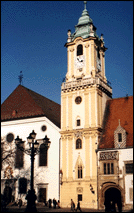
The Main Square is the historical heart of the city. The 15th century Old Town Hall, now used as the Municipal Museum, the Baroque Jesuit Church and aristocratic palaces, encircles it. The Rolland Fountain, standing in the middle of the square, represents Knight Rolland, the patron of municipal laws. Though called "April 4 Square" for years after the city's liberation on that date by Soviet soldiers in 1945, it was only recently given its far more pragmatic current title. Perfect for coffee sipping.
 Michael's Gate with Tower (Michalska brana) Michael's Gate with Tower (Michalska brana) |
Michael's Gate is the only preserved one of the medieval municipal fortifications. It was built in the 2nd half of the 13th century. Its bulbous green crown, looming high above the nearby rooftops, serves as a sort of compass for travelers making their way through the old town's streets. The present day baroque shape of the tower dates from the period 1753-1758 when a copper sculpture of Archangel Michael was put on its top. It houses a permanent exhibition of weapons and the town's fortifications. A map on the cobblestones beneath the gate will tell you exactly where you are in relation to main places in the world.
 Venturska Street (Venturska ulica) Venturska Street (Venturska ulica) |
Due to concerts given at palaces lining the street, it came to be called Music Lane. Franz Liszt played in the garden pavilion of de Pauly Palace, Gejza Zichy, a student of Franz Liszt, performed at Zichy Palace and Wolfgang Amadeus Mozart, the child prodigy, gave a concert at Palfy Palace.
 The Slovak National Theatre (Slovenske narodne divadlo) The Slovak National Theatre (Slovenske narodne divadlo) |
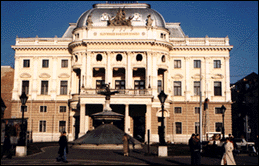
Opera, ballet and drama performances are held in this historical building designed by Austrian architects Fellner and Helmer. The opera ensemble offers up to 20 classical and modern productions composed by famous European as well as Slovak Composers. Ganymedes fountain, one of the most beautiful in the city, stands in front of the theatre.
 The Slovak National Gallery (Slovenska narodna galeria) The Slovak National Gallery (Slovenska narodna galeria) |
Hidden behind a communist monstrosity exterior, you can find a tasteful palace. Permanent exhibits include an impressive array of Gothic and Baroque statuary, as well as a collection of modern paintings by some of Slovakia's premier artists. Visiting exhibits are often of a very high quality - recent shows have included for example the works of Andy Warhol (who was of Slovak ancestry).
 Botanical Gardens (Botanicka zahrada) Botanical Gardens (Botanicka zahrada) |
Only open in summer the botanical gardens attached to Comenius University provide a lovely place to escape from city living. Park benches are generously sprinkled throughout the grounds.
 Devin Castle (Hrad Devin) Devin Castle (Hrad Devin) |
The mighty castle, towering above the confluence of the Danube and the Morava rivers, is one of the most significant archaeological sites in Slovakia. The Devin Castle is one of the most important archaeological areas in Slovakia. The excavations, dating to the 5th millennium BC show that the most well represented cultures were the Latene, Roman and the Great Moravian. The fortification of the Slavic Duke Rastislav Dowina is mentioned as early as in the annals of the 9th century. After the fall of the Great Moravian Empire of the old Slavs, the Devin Castle settlement became an important strategic fortification of the Hungarian Monarchy. Later, it passed on to the ownership of several rich families who carried out construction of some parts of the castle and its ramparts. Napoleon's soldiers blew up the castle in 1809. The castle is partly reconstructed, archaeological excavations continue.
As far as Soviet monuments go this is quite pleasant, perhaps due to its location on a plane high above the city. Well worth the climb, Slavin features a cemetery filled with the graves of fallen soldiers and a 37 m high column crowned with a soldier crushing a swastika. Unveiled in 1960, this is one reminder of the socialist past destined to be around for a long time to come.
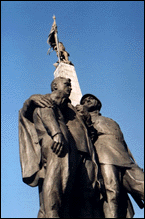
 Communism Communism |
Visitors seeking communist monuments or relics in Bratislava are likely not to find anything substantial. Unlike Budapest, where a slew of Lenin statues and hammer-and-sickle mementos have been gathered into an exhibition for tourists, Bratislava has steadily and thoroughly done away with blatant reminders of the socialist past (outside the Slavin memorial, which is less a paean to communism than to fallen Russian soldiers and a pleasant place to boot). That being said, there is no more potent visual reminder in perhaps any other city of communism's destructiveness than Bratislava's New Bridge, (Nový most). The construction of the bridge in 1972 caused the destruction of as much as two thirds of the historical old town, thus forever scarring the city with an attempt at social engineering for the masses. According to their perverted logic, the communist government of the time felt the bridge would serve as a nice counter-balance to the graceful majesty of Bratislava castle. The endless blocks of insipid apartment buildings in the Petrzalka district also testify to what was a decidedly ugly period in recent history. |

